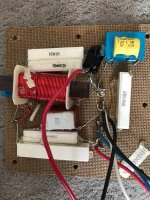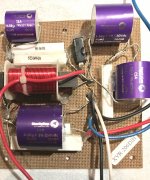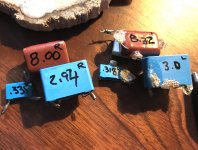Swapping capacitors can affect the frequency response slightly (~ 1 dB) if the originals are electrolytics in good shape. If the originals are aged electrolytics, the difference can be large (several dB).
For information, the original capacitors were said to be mylar or polypropylene types. Information about these speakers here:
SoundStage! Equipment Review - Clements 206di Loudspeaker (11/1997)
It is not completely clear to me what 'bypass' refers to. Does it refer to 'bypass crossover configuration' (what does that mean?) or to 'generic capacitors bypassed by mylar or polypropylene capacitors'?SoundStage said:The crossovers are hand built and hard wired using mylar and polypropylene capacitors in a bypass configuration.
Last edited:
Attachments
Last edited by a moderator:
At this point much has happened. All I can say is try a little resistance in your crossover.I am very interested in your input.
At this point much has happened. All I can say is try a little resistance in your crossover.
Thanks for the advice. I used this technique toning down a Grado Reference Sonata cartridge retipped with a contact line stylus and ruby cantilever. Ran A resistor parallel on my my RCA Y input (made a plug in) to the phono pre amp. I’ll do a little math to figure out where to start.
I am motivated by the fact you liked the sound before and want to get it back. I would start adding the resistance in series with the cap. I would start with less than an ohm.OK now the sound prior to the rebuild was very warm with great mid, lower frequency spatial qualities.
This is for your tweeter. If the woofer has changed much that's another story.
Wait- did I read about you moving a treble EQ knob back to center position? That is where it should be. Boosted is likely going to make it tilted up as you described.
Later,
Wolf
Later,
Wolf
Blowby, did you change a large electrolytic cap going to ground in the bass section? If so, swap it back. If this fixes your problem, you need to measure the ESR and compensate for it before swapping.
Blowby, did you change a large electrolytic cap going to ground in the bass section? If so, swap it back. If this fixes your problem, you need to measure the ESR and compensate for it before swapping.
I don’t know if I even have one.
Before:
After:

Last edited:
Double check the 8uF. Sure it wasn't 80?
Are you saying 8 is low and the original set might be much higher? I’m not familiar with what a standard configuration would be. I sent my original capacitors to Madisound who checked and sent the ones in the “after” photo.
It would be nice if you had a full schematic to share. I wasn't sure where that 8 uF was. It's a little low for the second pole of a low pass filter, so that's why I wondered about it.
Clarity caps are spot on. Can you measure the ESR ???
I don’t have an ESR meter.
Please swap back the squarred capacitor, you certainly moved from MKT caps (yellow is MKP or MKC or MKT?) towards Polypro which may explain less ESR with the Claritys and the perceived change + bias (you are so focused on a change that you may hear it wheither it happens)
What do you hear when going back with the formers ?
What do you hear when going back with the formers ?
I am motivated by the fact you liked the sound before and want to get it back. I would start adding the resistance in series with the cap. I would start with less than an ohm.
This is for your tweeter. If the woofer has changed much that's another story.
AllenB, looking on line I see single resistor like you recommended and 2 resistors. I have the second resistor to match your 1 ohm recommendation. I don’t know what difference I would hear going to 2 resistors.
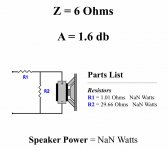
Your situation is a special one and it is not about attenuating the tweeter (even though it looks that way).
Normally I would encourage you to consider two resistors for the reduced source impedance at the speaker node, however, your position is specifically compensating for a replaced capacitor.
When a capacitor is changed and it has a different ESR and you want to compensate directly, then you should use one resistor.
Normally I would encourage you to consider two resistors for the reduced source impedance at the speaker node, however, your position is specifically compensating for a replaced capacitor.
When a capacitor is changed and it has a different ESR and you want to compensate directly, then you should use one resistor.
Your situation is a special one and it is not about attenuating the tweeter (even though it looks that way).
Normally I would encourage you to consider two resistors for the reduced source impedance at the speaker node, however, your position is specifically compensating for a replaced capacitor.
When a capacitor is changed and it has a different ESR and you want to compensate directly, then you should use one resistor.
Thanks for the explanation. I’m adding the resistor now. I made an add on to the end of the tweeter connection from the crossover board with a 1ohm resistor soldered under the shrink tube. I think this is the direction you advised.
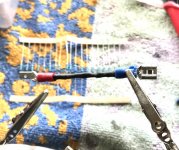
Last edited:
- Home
- Loudspeakers
- Multi-Way
- Capacitor swap, missing warmth....

